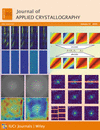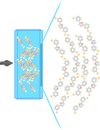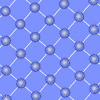issue contents
February 2024 issue

Cover illustration: Kleemiss et al. [J. Appl. Cryst. (2024), 57, 161–174] present an implementation of Slater-type spherical scattering factors for X-ray and electron diffraction within the software Olex2. Here, electron-density maps are used to highlight the differences between results obtained from the new approach and the currently popular `four Gaussian plus constant' method.
editorial
Open  access
access
 access
accessArtificial intelligence is more present than ever, both in our society in general and in science. At the center of this development has been the concept of deep learning, the use of artificial neural networks that are many layers deep and can often reproduce human-like behavior much better than other machine-learning techniques. The articles in this collection are some recent examples of its application for X-ray photon science and crystallography that have been published in Journal of Applied Crystallography.
research papers
A novel method for indexing electron backscattered diffraction (EBSD) patterns is found to be significantly more accurate and faster than traditional indexing methods.
Open  access
access
 access
accessA method and associated Python script, VanVleckCalculator, are described for parameterizing octahedral shear and first-order Jahn–Teller distortions in crystal structures.
Open  access
access
 access
accessMachine learning is used to analyse pair distribution functions obtained from polyoxometallate clusters. The new classifier POMFinder can rapidly screen a database of structures and identify which model is most suitable for describing the experimental data.
Open  access
access
 access
accessThe observation of neutron interference using a triple Laue interferometer formed by two separate crystals opens the way to the construction and operation of skew-symmetric interferometers with extended arm separation and length. The specifications necessary for their successful operation are investigated here. In contrast with previous studies, both incoherent sources and the three-dimensional operation of the interferometer are considered.
Open  access
access
 access
accessA strained heterostructured nanowire is investigated using 2D Bragg ptychography and scanning X-ray diffraction.
This work establishes (i) the detailed crystallographic orientation relationship spectra of magnetite in plagioclase, (ii) a novel structural principle generally applicable for optimal structure matching between plagioclase and other silicates/oxides, and (iii) realistic nucleation and growth models for magnetite in plagioclase.
A rapid heating and cooling sample furnace enables time-resolved in situ studies of the kinetics and the mechanisms of fast reactions and transformations.
This paper introduces for the first time texture measurements with an X-ray diffractometer mounted on a robotic arm, thus enabling texture mapping of complex sample geometries without the need to cut coupons from the sample. The new method was validated, and convincing results were obtained for both pole figures and orientation distribution functions.
Download citation


Download citation


The correlation between crystal structures and their bending properties is explored.
The present study gives an insight into variations in structural, optical and third-order nonlinear properties of an L-ascorbic acid single crystal on the application of shock waves.
Open  access
access
 access
accessX-ray absorption spectroscopy (XAS) measurements of N-truncated amyloid-β samples were corrected for systematic effects such as dead time, detector efficiencies, monochromator glitches, self-absorption, radiation damage and noise at higher wavenumbers k, permitting hypothesis testing in structural refinements. A new protocol was developed using extended X-ray absorption fine structure data analysis for monitoring radiation damage in real time and post-analysis.
Unbiased particle conformation extraction from scattering spectra using orthonormal basis expansions
A strategy based on the orthonormal basis expansion approach is proposed for extracting the density profile of soft-matter solutions from their small-angle scattering signatures.
A computational approach is applied to model and predict the results of X-ray resonant magnetic reflectometry. With the use of circularly polarized photons the method can be extended to magnetic systems to produce a map of dichroic reflectance, which can provide valuable information on the magnetization of individual sublayers of a multilayer heterostructure.
Open  access
access
 access
accessAnalytical scattering factors for X-ray and electron diffraction from spherical Slater-type orbitals are implemented in Olex2 to overcome shortcomings of interpolation and fitting methods and compare refinement results.
Open  access
access
 access
accessA method to determine the order in which parameters should be added to a Rietveld refinement is presented.
teaching and education
Open  access
access
 access
accessMost introductions to the topic of crystallography only occur during tertiary education, which presents a challenge to communicating it to wider groups. This work describes a simple activity targeted at classroom and community audiences to demonstrate crystal structure(s) and the wider impact of crystallography.
computer programs
Open  access
access
 access
accessProLEED Studio is software designed for simple, intuitive and precise modeling of low-energy electron diffraction patterns.
Open  access
access
 access
accessBioXTAS RAW is a free open-source program for reduction, analysis and modelling of small-angle scattering data. This article describes the new and improved features in RAW version 2, including new tools for liquid-chromatography coupled data processing, advanced reporting capabilities and a new API.
laboratory notes
Open  access
access
 access
accessA device for automated cleaning of piezo-actuator-driven picolitre-droplet dispensers required for the liquid application method for time-resolved analyses is presented.
Open  access
access
 access
accessThis work reports the successful construction of an anomalous ultra-small-angle X-ray scattering (AUSAXS) measurement system at the BL28XU beamline at SPring-8. A minimum of q = 0.0069 nm−1 was attained and time-resolved measurements were carried out by performing scattering measurements at 17 different energies in 30 s.

 journal menu
journal menu









































